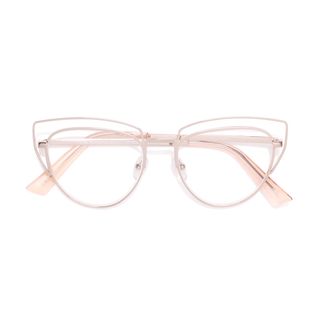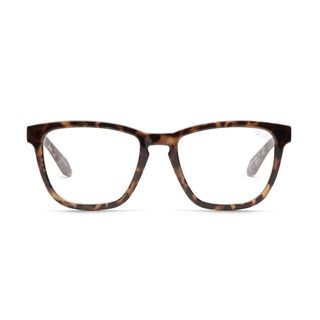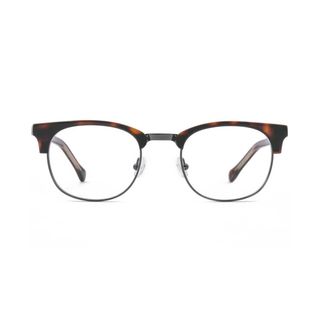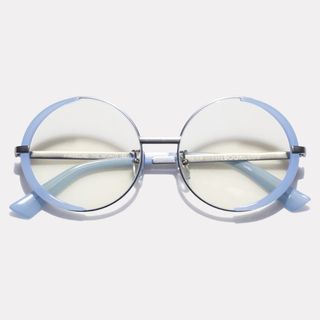Statistics Say You're Probably Suffering From Eyestrain—Here's the 411

Our generation is more than privy to the negative side effects that staring at our phones and computers can wreak on our psyche and mental health. What's less talked about, however, is how our increasing dependence on screentime (be it for work or pleasure) is doing a simultaneous, highly dysfunctional number on our vision and causing a widespread yet relatively silent epidemic of eyestrain. According to The Vision Council, roughly 80% of American adults say they spend more than two hours a day staring at their blue-light devices (with 67% using two devices simultaneously), and a whopping 59% report symptoms of eyestrain. Certain types of eyestrain are due to pre-existing conditions that fall out of our realm of control, but in most cases, the condition is inextricably linked to the love affairs we harbor for our collection of phones, laptops, tablets, and more.
As Alastair Cook, an Australian optometrist and expert to The Book Club Eyewear explains, eyestrain is classified as visual discomfort, generally worsened during visually demanding tasks such as computer use and prolonged use of electronic devices—a trend that's occurring, as we mentioned, in an ever-increasing number of adults in addition to teens and children. Of course, eyestrain is hardly a death sentence (though it may riddle you with soreness, fatigue, and eyes that feel like they hate you), and there are plenty of methods to strategically reduce and/or treat the condition before it manifests in more serious ways. Ahead, we discuss eyestrain—and how to reduce it—with Cook at length. Keep scrolling, but just dim your computer slightly, huh?
Symptoms & Causes
Brace yourself because you've likely experienced some—if not all—of the symptoms associated with eyestrain. According to Cook, the most common symptoms related to eyestrain include tired and or uncomfortable eyes (you know when your eyes just, um, hurt?), frontal headaches, and blurred vision. Additionally, Mayo Clinic cites watery eyes, increased sensitivity, decreased concentration, and even soreness surrounding the neck, shoulders, or back as additional clues. Sound familiar?
"Common causes include refractive error (aka conditions like nearsightedness and farsightedness), binocular vision disorders such as accommodative insufficiency, and visually demanding tasks like high smartphone use, computer work, etc.," Cook explains. However, other unexpected lifestyle habits might also put you at risk or exacerbate underlying eye conditions like reading without taking breaks to rest your eyes, driving for long distances, being exposed to super-bright light or intense glare (again, dim that screen, people!), straining to see in dim light, stress and fatigue, or even exposure to dry air moving from a fan or air conditioner.
When to See a Doctor
Despite how prevalent eyestrain is, if you're still experiencing worrisome, unusual, or life-hindering symptoms, it's paramount to see your trusted healthcare professional. (While we always want to help and provide important information here at The/Thirty, we never want to encourage self-diagnosis.) An ophthalmologist or optometrist will be able to look at all of your symptoms and give you a true diagnosis, and a far more customized treatment plan. Plus, like your routine physicals, biennial eye exams are important for staying on top of your whole-picture health (and productivity!) as well.
"Adults should receive an eye exam every two years at minimum, and sooner if any of the above symptoms are present or of any concern," confirms Cook. "It's also a good idea to visit a doctor if you're starting a new role involving visually demanding tasks to safeguard against the above."
From a physical standpoint, and if ignored, Cook tells me eyestrain can lead to a multitude of complications or other non-serious yet non-ideal issues like the formation of premature wrinkles. In a broader context, however, he explains eyestrain can lead to tiredness—presenting itself physically as stress, anxiety, headaches, tension, and more. "In the workplace, this tiredness from eyestrain can even result in workplace disagreements due to stress, clerical errors due to reduced vision, etc.," he warns.
How to Reduce and Treat Eyestrain
As mentioned, eyestrain can be precipitated by multiple perpetrators—underlying vision conditions included—so it's best to check with your doctor for a personalized game plan if you are, or think you are, suffering from eyestrain. That said, there are some universal truths when it comes to preventative treatment measures which may also help alleviate some, if not all, of your symptoms. Cook advises as follows:
Try blue-light glasses: By helping to curb refractive vision issues, these types of glasses make visually demanding tasks more manageable and also offer glare protection. (To break the fourth wall, I absolutely swear they've helped me get better sleep while simultaneously making my eyes less twitchy. Pus, they're cute AF. Read my full review, here.)
Limit or break up active screen time: According to Cook, something as simple as taking a coffee or bathroom break (or you know, having a face-to-face conversation with your deskmate) offers your vision regular breaks from otherwise visually demanding tasks.
Ensure proper humidity in your home and workplace:"If you're constantly in front of screens and computers all day, chances are you're not blinking as often, which can cause or worsen dryness," says Cook. Thus, maintaining enough humidity wherever you're working or looking at your screens the most (so maybe your bedroom, too) prevents excessive tear evaporation, which is often linked to with visually demanding tasks and screen time.
Check your ergonomics: "Screens and glare sources positioned at optimal angles and distances are easier to use, thus leading to less eyestrain," Cook adds.
Distance yourself: Remember when Mom told you to back away from the TV? Yep, she was most certainly on to something and still knows best—much to our disdain. "Too-close working distances tend to lead to more accommodative demand and therefore more eyestrain," confirms Cook.
Receive a full eye exam (including binocular vision workup) every two years: As mentioned, regular checkups will ensure timely correction for any issues that do arise while also making sure you're performing at peak visual performance if you have demanding tasks at work or home.
Oh, and if you're curious to try out some game-changing blue-light glasses for yourself, shop all of our favorites below!
Disclaimer
This article is provided for informational purposes only and is not intended to be used in the place of advice of your physician or other medical professionals. You should always consult with your doctor or healthcare provider first with any health-related questions.
Erin has been writing a mix of beauty and wellness content for Who What Wear for over four years. Prior to that, she spent two and half years writing for Byrdie. She now calls Santa Monica home but grew up in Minnetonka, Minnesota, and studied writing, rhetoric, and communication at University of Wisconsin, La Crosse. She studied abroad in Galway, Ireland, and spent a summer in L.A. interning with the Byrdie and Who What Wear family. After graduating from UW, she spent one year in San Francisco, where she worked as a writer for Pottery Barn Kids and PBteen before moving down to L.A. to begin her career as a beauty editor. She considers her day-to-day beauty aesthetic very low-maintenance and relies on staples like clear brow serum (from Kimiko!), Lawless's Lip Plumping Mask in Cherry Vanilla, and an eyelash curler. For special occasions or days when she's taking more meetings or has an event, she'll wear anything and everything from Charlotte Tilbury (the foundations are game-changing), some shimmer on her lids (Stila and Róen do it best), and a few coats of the best mascara-type product on earth, Surratt's Noir Lash Tint.





